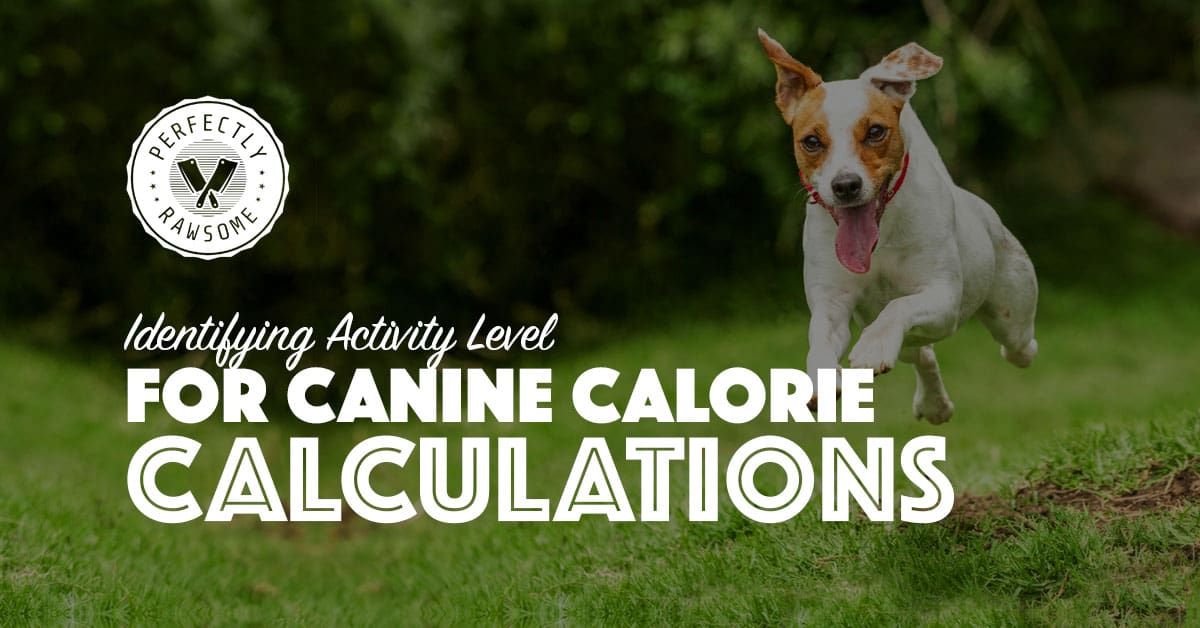The amount of calories an adult dog requires is dependent on multiple factors. Pet parents adopt the responsibility of ensuring their dog’s home prepared fresh food diet provides sufficient calories to support biological function, daily activity, and lean body mass.
Identifying a dog’s calorie requirement is an important step when creating a balanced home prepared diet. There are multiple variables that contribute to calculating calories:
Terminology Definitions
There are multiple terms used when discussing calorie calculations.
Calorie Calculation Variables
There are eight variables that affect the energy needs of a dog that should be considered when calculating calorie requirements.
Calculation Changes
The standard energy needs can be adjusted based on the individual dog’s metabolism.

Terminology Definitions
Throughout this article, there will be multiple terms and acronyms used when explaining the process of calculating calories for adult dogs. Below is a consolidated list of those terms and their definitions:
Calories
Calories are units of energy that the body utilizes as fuel to support biological function and daily activity.
Resting Energy Requirement (RER)
The Resting Energy Requirement is the energy required when an animal is at rest under non-fasted and thermoneutral conditions.
Daily Energy Requirement (DER)
Daily Energy Requirements consist of RER plus the additional energy required for exercise, growth, pregnancy or lactation. DER is also affected by factors such as breed, neuter status, disease, or environmental conditions.
Body Condition Score (BCS)
BCS is a number system designed to evaluate fat depositing throughout the body. It is used to determine if a pet is underweight, ideal, overweight or obese.
Activity Duration
Activity duration is the amount of time a dog spends performing one session of physical activity.
Activity Intensity
Activity intensity is the amount of physical power used when performing an activity. It is expressed as a percentage of the maximal oxygen consumption.
Calorie Calculation Variables
The issue with the standard multipliers is that they do not take into account all of the different variables that influence a dog’s daily calorie requirements. These multipliers must be adjusted to the individual dog’s needs in order to avoid under or over feeding. Multiple factors that often affect a dog’s calorie requirements are body condition score, daily activity, breed size, life stage, reproductive status, climate, medical conditions, and individual metabolism.
| Activity Level | Energy Needs |
|---|---|
| Weight loss | 1 |
| Obese Prone | 1.2 |
| Inactive | 1.4 |
| Neutered | 1.6 |
| Intact | 1.8 |
| Underweight | 1.4-2 |
| Performance or Work | 2-5 |
*Energy need multipliers are for dogs 12-18 months and older.
There are standard formulas for calculating an estimated daily calorie intake for adult dogs. However, every dog is an individual and there are multiple factors that often change a dog’s calorie requirements. The standard formulas do not take into account all of the individual factors that contribute to calorie needs. Therefore, which means it is up to the pet parent to determine their dog’s customized calorie intake.
Body Condition Score
Determining a dog’s current Body Condition Score (BCS) based on a physical assessment is the most accurate way when identifying if a dog is underweight, ideal weight, overweight, or obese. The BCS establishes if the calorie requirements should be increased, decreased, or remain the same.

Underweight
Underweight dogs require a calorie increase to achieve ideal body weight. It is important to rule out underlying medical conditions or parasites with a veterinarian when a dog is underweight while eating a high amount of calories. If health is clear, digestive enzymes may be helpful in these situations. Additionally, the diet should be evaluated for nutritional adequacy.
For dogs who are truly emaciated, an increase in food intake must be approached very slowly under the guidance of a veterinarian in order to avoid the dangers of “refeeding syndrome.”
Ideal Weight
Calorie intake does not need to increase or decrease if a dog is maintaining ideal body weight when consuming the current calories the diet provides. Therefore, the total amount of calories the current diet provides serves as a starting point for calorie requirements when transitioning an adult dog to a home prepared fresh food diet.
Due to the macronutrient change between dry dog food and fresh food, some dogs may require a higher calorie intake on fresh food.
Overweight & Obese
Overweight and obese dogs may require a combination approach in order to achieve their ideal weight. Current calorie intake should be evaluated and reduced within reasonable limits. When a dog is severely obese and requires a significant reduction in calories, this should be approached gradually and not all at once. An increase in safe exercise is also encouraged especially if calorie intake is low. Occasionally, dogs will lose the necessary weight simply from changing from high-carbohydrate commercial food to low-carbohydrate fresh food.
Some dogs may require a daily calorie intake that is lower than their calculated RER in order to lose weight or maintain their ideal weight. This can potentially result in various nutrient deficiencies due to the extremely limited amount of food. In these cases it is recommended to have the diet formulated by a professional nutritionist to ensure that the diet is more concentrated in nutrients.
Activity Level
The amount of physical exercise a dog does in a day is one of the main contributing factors to calorie requirements. The more active a dog is, the more fuel is required to provide the body with sufficient energy to sustain biological function and maintain ideal body weight.
| Activity Level | Activity Duration |
|---|---|
| Sedentary | 0-30 minutes of daily activity |
| Low Activity | 30 minutes – 1 hour of daily activity |
| Moderate Activity | 1-2 hours of daily activity |
| High Activity | 2-3 hours of daily activity |
| Working & Performance | 3+ hours of daily activity |
Not all physical activity is equal. Activity duration and intensity play a role in the type of physical exercise dogs receive daily. For example, a 30 minute leash walk is not as intense as a 30 minute jog even if the duration of the activity remains the same.Therefore, the activity level will be low-moderate if a dog typically has low intensity exercise; and the activity level will be high-moderate if a dog typically has high intensity exercise.
Breed Size
Certain breeds are genetically predisposed to obesity and may require a lower calorie intake than the average. These breeds include Beagles, Golden Retrievers, Labrador Retrievers, Bulldogs, Pugs, Dachshunds, French Bulldogs and more.
Arctic breeds such as the Husky or Malamute have been observed to subsist on lower than average calories despite the high levels of activity they were bred for. They are well known for being “picky” eaters which may stem in part from being unknowingly overfed.
Life Stage
The age and life stage of a dog also affects calorie intake. Pregnant and lactating females will often need an increase in caloric intake throughout gestation and lactation. Young animals often have higher metabolisms, more lean body mass, and higher activity levels than older dogs. Therefore, young dogs may require higher calories and their calorie needs may reduce with age. Older dogs may have a reduced Resting Energy Requirement (RER) due to higher body fat and less lean body mass. Studies indicate that dogs over 7 years old require 10-20% less caloric energy than dogs that are 3-7 years old.
Reproduction Status
It is well known that spaying and neutering can often result in weight gain and obesity due to a combination of factors. In neutered dogs, obesity occurs twice as often as in intact dogs.
Climate
The climate a dog lives in will increase or decrease their calorie requirements. The thermoneutral zone is the temperature range where a dog reaches their minimum metabolic rate. This is the temperature range where they are not expending energy keeping warm or cooling off. The thermoneutral zone is higher for short haired dogs and lower for long haired dogs, with Alaskan sled dogs being potentially even lower. Dogs who spend significant time outside in cold weather will expend energy in maintaining their core body temperature. This results in a higher daily calorie requirement. How much calorie needs increase will depend on the breed, coat length and density, wind chill, humidity, and degree of acclimatization.
Medical Conditions
Certain medical conditions, injuries, and medications can affect a dog’s appetite and calorie requirements. Injuries or medical conditions that require a decrease in activity warrant a decrease in calorie intake. However, some conditions and medications can increase appetite and metabolism, requiring a calorie increase to maintain ideal weight.
Individual Metabolism
Above all, a dog’s individual metabolism is the deciding factor on calorie intake. Despite what any of the above factors or the standard formulas indicate, an individual may have a higher or lower metabolism than expected. The only way to account for this is by observing the dog’s body condition in comparison to their calorie intake.
Calculation Changes
Calculating calories for a dog should be based on all factors that contribute to energy needs. Therefore, based on the factors discussed above and professional experience, the multipliers can be modified for a general guideline that may be more accurate for most adult dogs:
| Activity Level | Energy Needs |
|---|---|
| Weight loss | 0.8-1 |
| Obese Prone | 0.8-1.1 |
| Inactive | 1-1.2 |
| Neutered | 1.1-1.4 |
| Intact | 1.3-1.6 |
| Underweight | 1.6-2 |
| Performance or Work | 2-5 |
*Energy need multipliers are for dogs 12-18 months and older.
Current Calorie Intake
The easiest way to calculate daily calorie requirements is to simply consider the dog’s current diet. Commercial dry, canned, or raw foods should provide a calorie content on the label per cup, can, ounce, or kilogram. This information can be used to calculate the dog’s current calorie intake. Once the current intake is known, the next step is determining whether the calories should be increased or decreased by observing the dog’s body condition.
CLOSING COMMENTS
Calculating how many calories a dog should consume is based on multiple variables. Identifying the dog’s BCS is the starting point to determining if the dog’s current calorie intake is appropriate or needs to be adjusted. Activity level, breed size, life stage, reproductive status, climate, medical conditions, and individual metabolism are all variables to consider when calculating calorie requirements.
It is important to consider the effect these variables have and adjust the standard calculation guidelines for the individual dog’s needs. However, considering the dog’s current calorie intake in relation to their body condition can be the simplest way to determine ideal calorie requirements.


